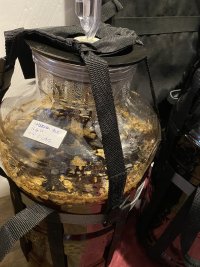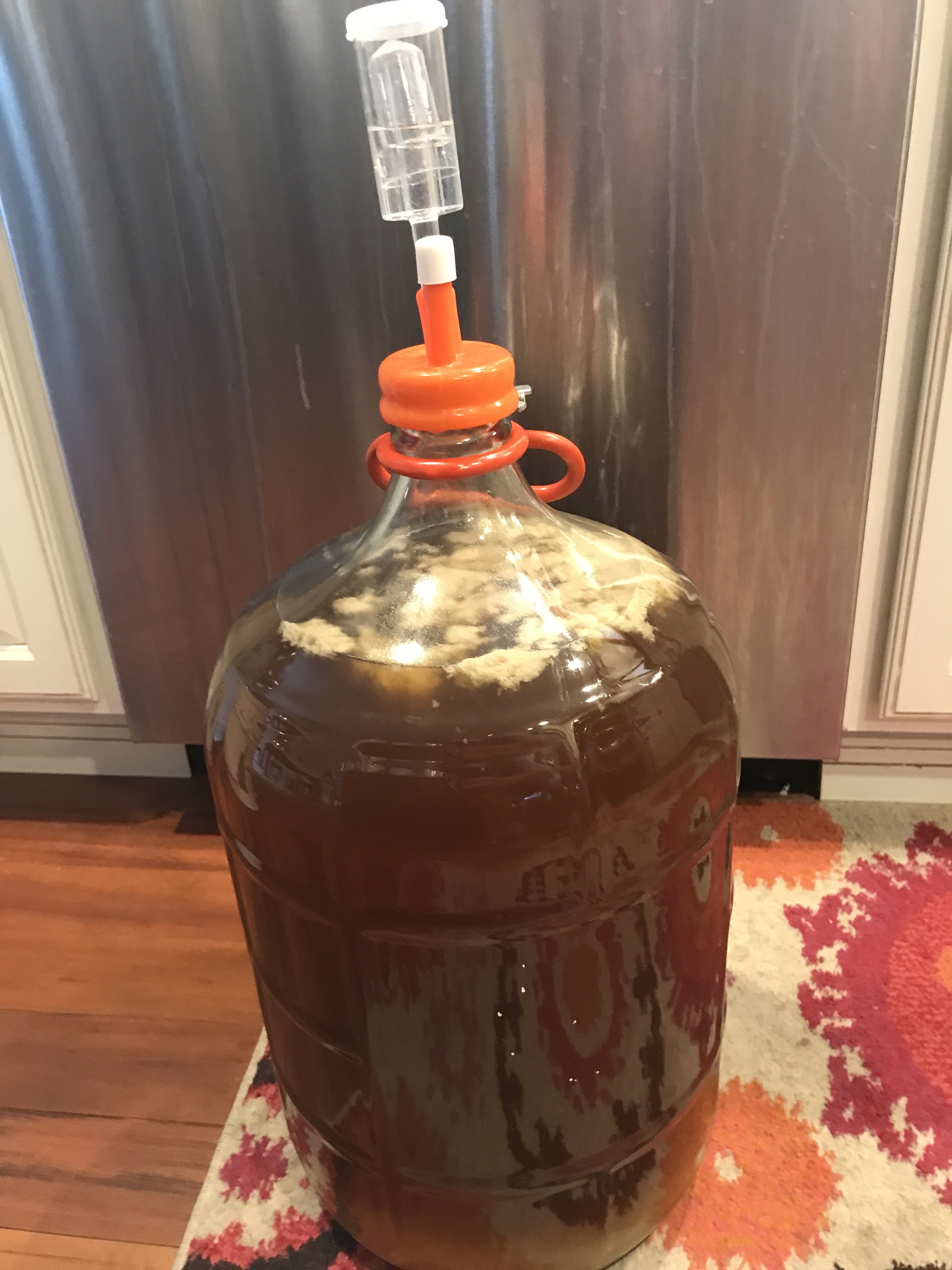This is an American Ale from extract kit. Got it from MoreBeer. I am approaching the second week of fermentation. There are these large clumps rising and falling out of the beer and it is still active. I removed the bung to take a small whiff and it smells ‘off’. Not sure if it supposed to smell like that because it apparently is not done fermenting or if there is some contamination. Any thoughts?
You are using an out of date browser. It may not display this or other websites correctly.
You should upgrade or use an alternative browser.
You should upgrade or use an alternative browser.
Strange clumps in primary fermenter
- Thread starter Architect-Dave
- Start date

Help Support Homebrew Talk - Beer, Wine, Mead, & Cider Brewing Discussion Forum:
This site may earn a commission from merchant affiliate
links, including eBay, Amazon, and others.
my best guess, yeast...give it a jiggle and they'll sink....
CleanEmUpIves
Well-Known Member
1.) Which yeast did you select?
2.) Did you use tap water or RO/distilled water?
3.) Was it the DME or LME kit?
4.) What was the OG?
5.) Did you use yeast nutrient?
6.) What is the "off" smell?
Sometimes yeast clump together when a yeast cell clones itself, budding an identical "daughter cell," but fails to pinch the clone entirely free.
https://www.discovermagazine.com/planet-earth/yeast-show-humans-why-its-better-to-be-a-clump
My questions are just curiosity related to the question of does this occur due to environment (low food concentration), is it related more to genetics - or most probably both.
Swirling or gently sloshing the fermenter might break them up or cause them to sink.
2.) Did you use tap water or RO/distilled water?
3.) Was it the DME or LME kit?
4.) What was the OG?
5.) Did you use yeast nutrient?
6.) What is the "off" smell?
Sometimes yeast clump together when a yeast cell clones itself, budding an identical "daughter cell," but fails to pinch the clone entirely free.
https://www.discovermagazine.com/planet-earth/yeast-show-humans-why-its-better-to-be-a-clump
At low food concentrations, the clumpy cells easily outcompeted the individual cells, ending up with higher numbers in their population. When cheaters were thrown into the mix, clumpy cells retained their advantage. All around, clumping was a better strategy.
My questions are just curiosity related to the question of does this occur due to environment (low food concentration), is it related more to genetics - or most probably both.
Swirling or gently sloshing the fermenter might break them up or cause them to sink.
I sanitized a long spoon and gently stirred it. That seemed to do it.
1. SafAle 05 dry yeast.
2. Tap water with 1/2 Campden tablet.
3. LME kit.
4. O.G. Of 1.042.
5. No nutrient.
6. A kind of light sour smell. Not sure if that is the yeast, never made an American ale before and never smelled a beer halfway through fermenting. Could be completely normal.
1. SafAle 05 dry yeast.
2. Tap water with 1/2 Campden tablet.
3. LME kit.
4. O.G. Of 1.042.
5. No nutrient.
6. A kind of light sour smell. Not sure if that is the yeast, never made an American ale before and never smelled a beer halfway through fermenting. Could be completely normal.
Those clumps are probably proteins, perhaps combined with some yeast.
Leave it be, the yeast "knows" what to do.
When it's ready to package in another week or 2, you'll transfer the (clear) beer with a racking cane or siphon to a bottling bucket or keg. It will leave all the clumps, floating or not, and trub on the bottom behind, anyway.
No need to interfere, removing stoppers, airlocks, or do smell tests. No need for a secondary either, leave it where it is in the "primary" fermenter, at around 66-72F, the beer is still green, and needs to condition out for 2 weeks.
Leave it be, the yeast "knows" what to do.
When it's ready to package in another week or 2, you'll transfer the (clear) beer with a racking cane or siphon to a bottling bucket or keg. It will leave all the clumps, floating or not, and trub on the bottom behind, anyway.
No need to interfere, removing stoppers, airlocks, or do smell tests. No need for a secondary either, leave it where it is in the "primary" fermenter, at around 66-72F, the beer is still green, and needs to condition out for 2 weeks.
Thanks. I am new at this and just want to make sure. Each time I learn something new, it seems there is more and more I do not know.Those clumps are probably proteins, perhaps combined with some yeast.
Leave it be, the yeast "knows" what to do.
When it's ready to package in another week or 2, you'll transfer the (clear) beer with a racking cane or siphon to a bottling bucket or keg. It will leave all the clumps, floating or not, and trub on the bottom behind, anyway.
No need to interfere, removing stoppers, airlocks, or do smell tests. No need for a secondary either, leave it where it is in the "primary" fermenter, at around 66-72F, the beer is still green, and needs to condition out for 2 weeks.
CleanEmUpIves
Well-Known Member
Does anyone know what (factors) would coagulate proteins like that during fermentation?
The less you interfere, the better it is. Just keep the temps constant, on the low side of the yeast's range during active fermentation (there's foam, bubbling, etc.). When activity has slowed down you can raise the temps a few degrees to keep her engaged, help her finish out and condition your beer for another 2-3 weeks.Thanks. I am new at this and just want to make sure. Each time I learn something new, it seems there is more and more I do not know.
If it hasn't been suggested yet, reading John Palmer's How to Brew, 4th Ed. is recommended.
There was no need for doing that. It will be OK, not a major issue, just remember for next time that tinkering with your beer (and fermenter) is generally counterproductive.I sanitized a long spoon and gently stirred it. That seemed to do it.
Sorry, I was typing up my previous reply as you posted that. Now you'll know for next time.
Thank you everyone!
The proteins (they're in the grain and extracts) coagulate (as small flakes) and precipitate after the boil, while chilling. That's the cold break!Does anyone know what (factors) would coagulate proteins like that during fermentation?
Earlier on, during the boil, there can also be a hot break. But it's usually only with all grain or partial mash brews, especially when using large amount of protein rich grain such as wheat or rye or adjuncts.
Slow chilling could prevent a good solid cold break from happening. Adding half a teaspoon of Irish Moss 10' before flameout can help coagulating them better and settle out more completely. You would leave most or all that trub behind on the bottom of the kettle, only transferring the mostly clear wort on top to the fermenter.
If you dump the whole kettle's content into the fermenter all that protein is still in there too. Then with the yeast doing her thing, you may get those clumps! They're completely harmless.
Fermentations can be very gnarly, and smelly too.
I sanitized a long spoon and gently stirred it. That seemed to do it.
if that was a response to me...that's what I'D do, but most people would worry about O2, and a gentle rock back and forth would appease the LoDo crowd more....
Well, thanks everyone….We will see next weekend when I bottle it up.
Well, as a follow up, the clumps look worse and there is a sour acidic smell coming from the airlock. The bottom of the fermenter does not have the ‘sandy’ looking trub that you normally see, it looks like a light tan cottage cheese…I am. Not confident in this…
CleanEmUpIves
Well-Known Member
Post a picture of this phenomenon! All from the venerable 05 strain. Do you know the current SG?
Well, as a follow up, the clumps look worse and there is a sour acidic smell coming from the airlock. The bottom of the fermenter does not have the ‘sandy’ looking trub that you normally see, it looks like a light tan cottage cheese…I am. Not confident in this…
Well... that sucks. It was still worth leaving it to be sure. Give the beer an actual taste and if it does indeed taste bad then unfortunately it's time for it to go. Airlock smells aren't always great, they are mostly CO2, maybe a bit of your sanitizer, and yeast flavors that honestly aren't super pleasant.
Martys1
Well-Known Member
- Joined
- Oct 26, 2017
- Messages
- 107
- Reaction score
- 226
I get them all the time, I use Irish moss and wirfloc together and I always see clumps of yeast rising and falling and when I cold crash they fall to the bottom, the smell you mentioned is most likely Co2 , I wouldn’t worry
- Joined
- Mar 10, 2021
- Messages
- 2,726
- Reaction score
- 2,349
It is what it is. Don't just give up on it.…I am. Not confident in this…
Even infected beer might taste good. Quite a while back this year I had some infected beer that tasted nasty after being bottled and conditioned. But bottles I kept for several months actually developed a decent enough taste. Not great but not bad either. It was just a 1 gallon batch of beer. I wish in this case I'd had more bottles to leave longer and see what even longer time did for it.
Infection doesn't mean poison. Still, we aren't convinced it's infection you have.
CleanEmUpIves
Well-Known Member
I'm still back to why the yeast is clumping?
Maybe adding yeast nutrient (zinc) would cause the yeast to finish pinching off the clones.
Do these clumps biologically cooperate via their connection to the clone to process the food around them?
Maybe adding yeast nutrient (zinc) would cause the yeast to finish pinching off the clones.
Do these clumps biologically cooperate via their connection to the clone to process the food around them?
VikeMan
It ain't all burritos and strippers, my friend.
- Joined
- Aug 24, 2010
- Messages
- 5,853
- Reaction score
- 5,970
the smell you mentioned is most likely Co2
CO2 is odorless. And although it can cause a burning sensation in the nose, it doesn't evoke "sour" by any stretch of the imagination, at least in my imagination.
Well, I transferred it into my bottling bucket by passing it through a sanitized hop screen. Got all the gunk out. Smelled fine. Added my conditioning syrup to it and bottled it up. I tasted some before and after adding the priming solution and tastes fine. Am slowly learning that beer evolves its taste profiles while growing up. I will see in about a week or so after it conditions.
Yeah - kinda like that, but not as pillowy...
Similar threads
- Replies
- 1
- Views
- 384
- Replies
- 18
- Views
- 2K




